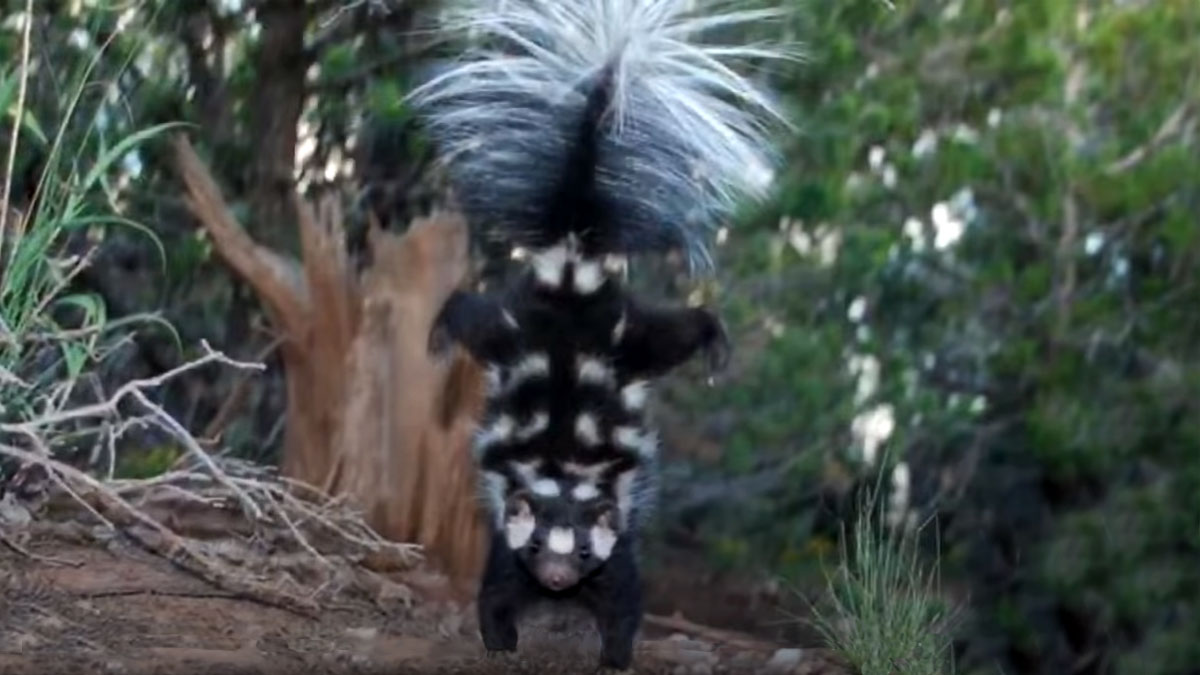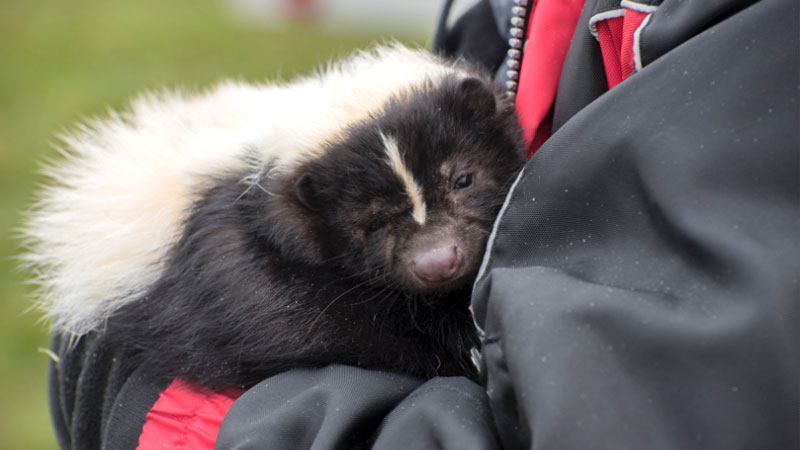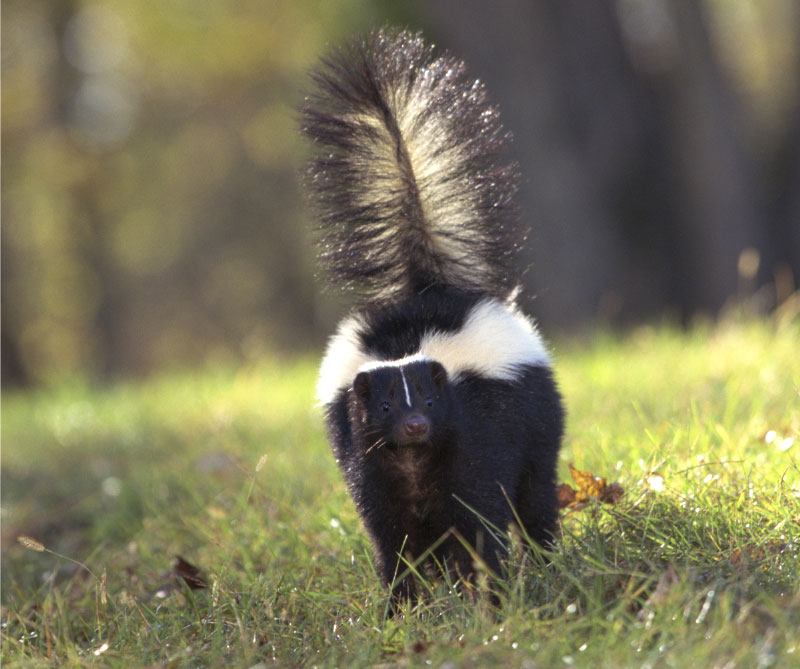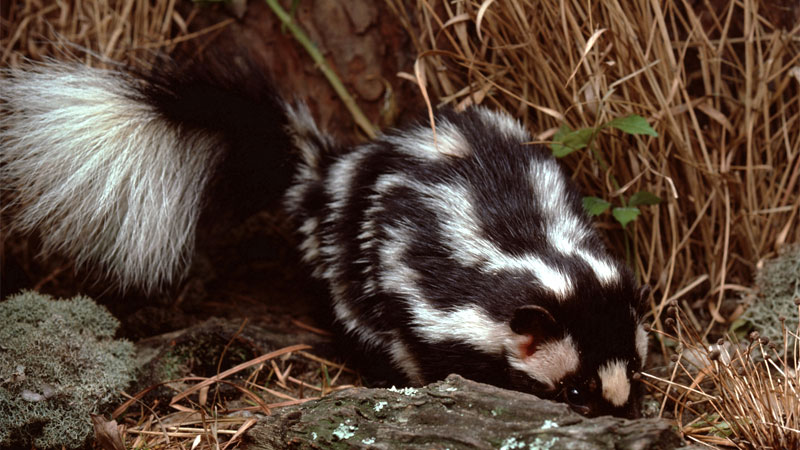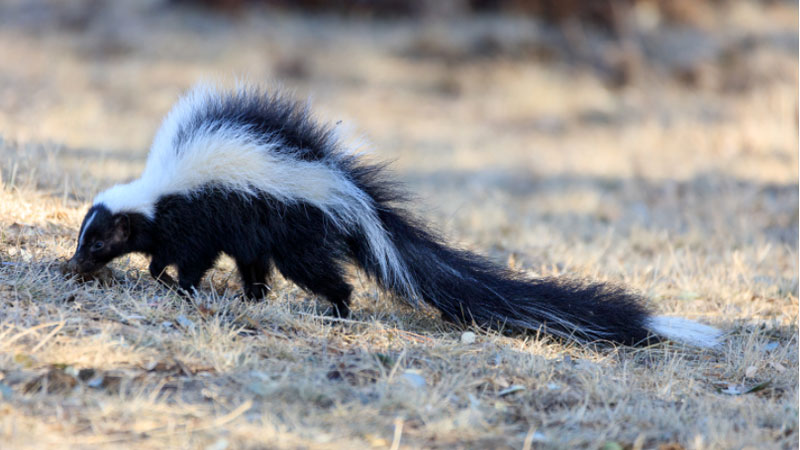They won’t win any sweetest smell awards, they’ll damage our gardens by nibbling on all kinds of vegetation, and topple over trash cans in search of food. Skunks get a bad rap but there’s more to them than meets the eye.
Read on for some eyebrow-raising science as we look at 13 revelations about Pepé Le Pew’s real life cousins.
Related: How to Get Rid of Skunks (Permanently)
Facts About Skunks
#1 – Skunks Make Decent Pets (When Descented)
Believe it or not, domesticated skunks can make pleasing pets for the right owners. Their intelligence, playfulness, affection, and litter box readiness are appealing traits.
Since most places outlaw owning wildlife, pet skunks are almost always ones that have had their scent glands surgically removed. This descenting allows them to interact amenably with owners.
#2 – Skunks Are Actually Carnivores
Even though they’ll eat anything from the garbage can, skunks are technically classified as carnivores. Their diet is usually based on a seasonably available prey – small animals during the winter and fall, and insects during the summer and spring.
#3 – They Give a Little Warning Dance Before They Spray
Before they spray, skunks will try to scare off a predator with an intimidating warning dance. In fact, they try to avoid spraying at their predator because it will render them helpless until they can “reload.”
The skunk’s series of maneuvers will include slapping their tails, stomping on the ground, and trying to look larger than their actual size.
#4 – They Do Handstands When Foraging
Striped skunks often stand on their front paws and do handstands while searching for food. This maneuver allows them to better locate insects, grubs, and other small prey as they probe the soil and grass with their long claws.
The extra lift while balanced on their front limbs gives them a broader vantage point to spot signs of food.
#5 – Their Musk is Their Last Resort
Skunks are shy animals that will avoid conflict as much as possible. In fact, they’ll always choose flight over fight. But when they feel threatened, they’ll make some sounds, take a few steps backward, raise their tail, and spray you with their smelly musk.
Here’s a tip: the next time you come face to face with a skunk in your yard, a simple “shoo!” will save you the stench.
#6 – Skunks Have Poor Vision
While skunks have excellent senses of smell and hearing, they have relatively poor eyesight. Their small beaded eyes allow decent night vision and detection of movement but offer fuzzy imaging.
It’s one reason skunks will often stomp their front feet as a warning before resorting to spraying; they tend to investigate an unclear sight by scent and sound first.
#7 – Can Skunks Climb Trees?
Skunks have long claws and sharp teeth for digging, but are not good climbers. They may try to climb boards, fences, and wire mesh to get into your yard, but they rarely climb trees. Their long, sharp nails are a definite handicap when it comes to climbing.
See Also: Identifying a Skunk Den
#8 – Can Skunks Swim?
Skunks can swim if absolutely necessary, but they typically avoid water and swimming long distances. Their dense, thick fur becomes waterlogged and heavy, making staying afloat more difficult the larger the body of water.
Many skunks will only enter water to cross short distances and seek out alternative routes when possible.
#9 – They are Categorized in a Family of Their Own
Skunks officially belong to the family Mephitidae in the taxonomy table. Mephitidae is a Latin word meaning stink – it can get any accurate than this.
They were initially grouped in the same family with badgers, otters, and weasels in the family Mustelidae. But unlike these animals, skunks spray their musk from an anal gland in a controllable manner.
This skunk family has close to ten different species which come in different coloration and sizes.
#10 – Their Spray Is Quite Powerful
Skunks can spray their musk up to 10 feet away. Apart from the pungent smell that can linger for up to two weeks, their spray is irritating enough to cause temporary blindness.
Moreover, this unpleasant smell can be detected by people a mile downwind.
#11 – Their Smelly Defense Mechanism Is Because They’re Nocturnal
Why do skunks have a malodorous self-defense tactic while other similar animals like meerkat utilize their large numbers for safety?
A study showed that this had to do with when a potential predator was active. Rodents that are active daytime are vulnerable to predators like carnivorous birds. Therefore, they depend on lookouts for warning in case of danger.
On the other hand, skunks are solitary and nocturnal, and therefore, more at risk to terrestrial predators. Their smelly musk is, hence, more effective.
#12 – Their Stripes Point Out to Their Sprayers
A National Geographic study showed that animals that chose fight over flight often had marks that drew attention to their best weapon.
So if it seems like the stripes on skunks are pointing to where the nauseating spray comes from, that’s because they are. Moreover, other animals like the badgers have stripes on its face which highlights their sharp teeth.
This will help keep off predators while conserving energy. It’s better to intimidate a threat than to actually spray them, right?
#13 – Skunks Walk on Tiptoes
A striped skunk’s normal gait has them perpetually walking on their toes. With heels permanently raised, they rock back on their hind feet and tread lightly on the toes. This gives them a distinctive tiptoeing stride.
It allows them to remain ready to face threats by quickly spinning around while keeping their billowy tail erect.
- How to Identify Skunk Poop (With Pictures) - April 1, 2024
- You Really Don’t Need That Opossum Trap - January 4, 2024
- How to Set a Mouse Trap Without Getting Hurt - December 28, 2023

